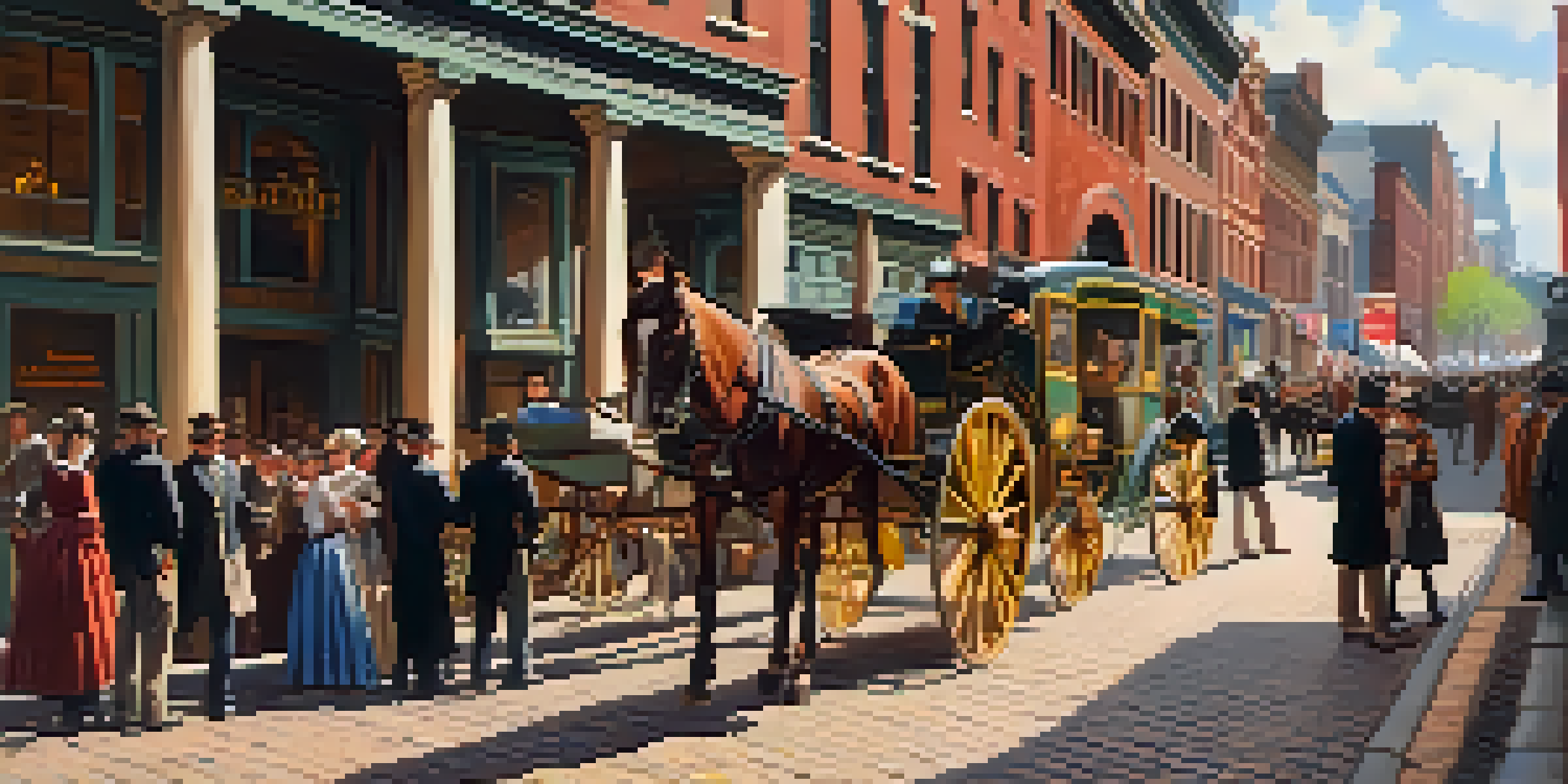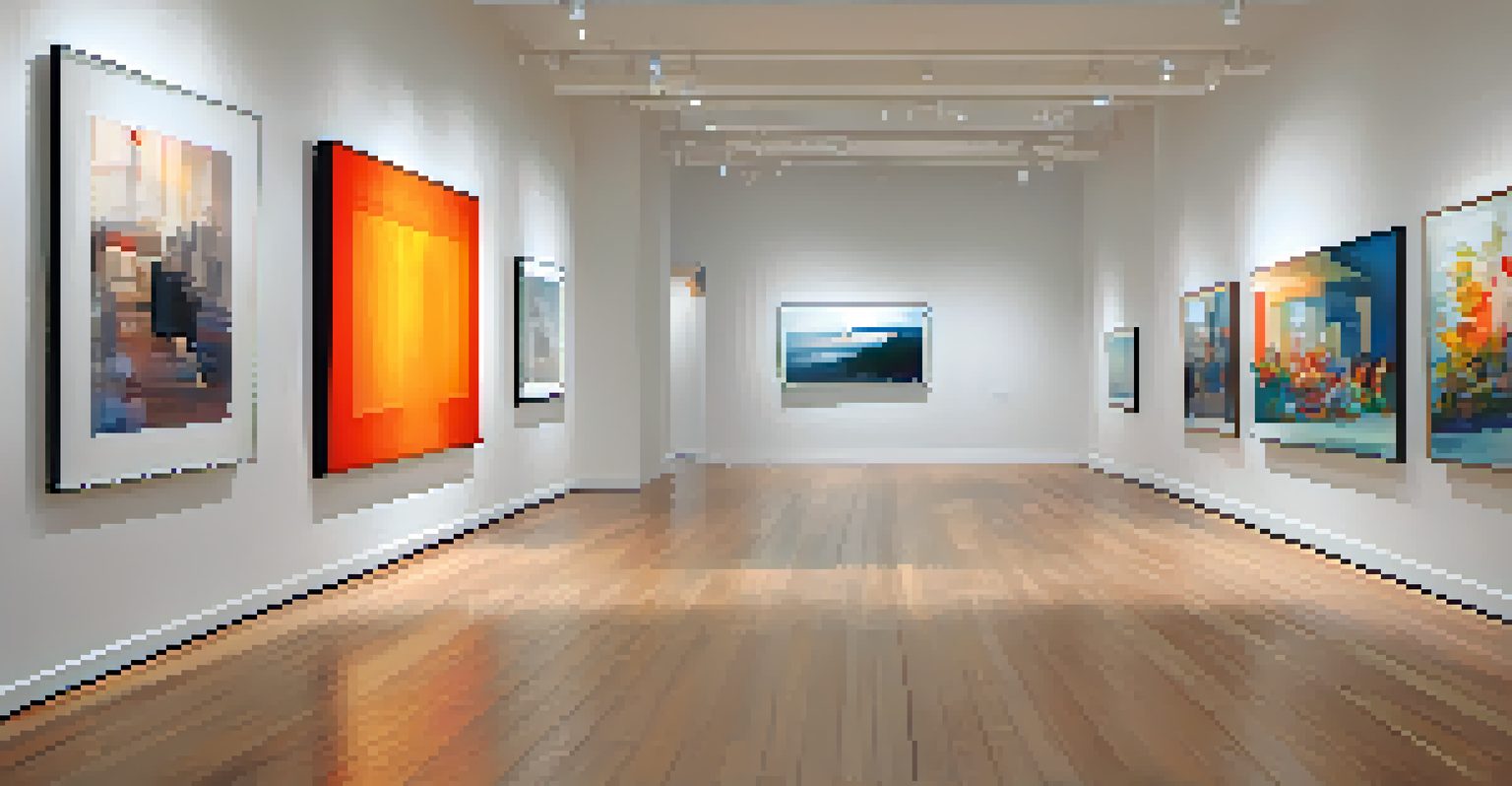The History of Art Galleries in Boston: A Cultural Journey

The Birth of Boston's Art Scene in the 19th Century
In the 1800s, Boston began to carve out its identity as a hub for art and culture. The establishment of the Boston Athenaeum in 1807 marked a significant milestone, offering a space for artists and art lovers to gather. This institution not only provided access to artistic works but also facilitated discussions that nurtured the local art community.
Art is not freedom from discipline, but disciplined freedom.
As the century progressed, more galleries emerged, reflecting the growing appreciation for the arts. The Museum of Fine Arts, founded in 1870, became a cornerstone of this cultural landscape, showcasing both American and European masterpieces. It played a crucial role in elevating the public's engagement with art, setting the stage for future galleries.
The influence of the 19th-century art scene can still be felt today, as many contemporary galleries draw inspiration from this rich history. Artists and curators continue to celebrate Boston's storied past through their works and exhibitions, making it a vibrant and evolving art destination.
The Impact of the Boston School on Art Galleries
The Boston School, a group of painters active in the late 19th and early 20th centuries, significantly influenced local art galleries. Their focus on realism and capturing the essence of everyday life resonated with both artists and audiences. This movement laid the groundwork for future generations of artists and collectors who sought authenticity in artistic expression.

As galleries began to showcase works from the Boston School, they attracted a diverse audience. The popularity of their art helped solidify Boston's reputation as a center for artistic innovation. This shift encouraged galleries to explore new styles and movements, further enriching the local art scene.
Boston's Art Scene Flourishes
The 19th century saw Boston establishing itself as a cultural hub with institutions like the Boston Athenaeum and the Museum of Fine Arts.
Today, the legacy of the Boston School can still be seen in various galleries that celebrate realism and traditional techniques. Their contributions serve as a reminder of the importance of community and collaboration in the evolution of art in Boston.
Modernism and the Rise of Contemporary Art Galleries
The early to mid-20th century brought a wave of modernism that transformed Boston's art galleries. With movements like Abstract Expressionism and Surrealism gaining traction, local galleries began to showcase these revolutionary styles. This shift allowed artists to explore new materials and concepts, challenging traditional boundaries.
The best artist has no conception that a marble block does not contain within itself the artist’s vision.
As contemporary art emerged, galleries adapted by incorporating innovative exhibition strategies. They began to host not just traditional art displays, but also performance art and installation pieces, inviting the public to engage with art in dynamic ways. This evolution attracted a younger audience, eager to explore the cutting edge of artistic expression.
In Boston, the embrace of contemporary art has led to the establishment of numerous avant-garde galleries. These spaces celebrate artists who push boundaries, ensuring that the city remains at the forefront of the modern art scene.
The Role of Non-Profit Galleries in Boston's Cultural Landscape
Non-profit galleries have become essential players in Boston's art ecosystem, offering alternative spaces for emerging artists. These galleries often prioritize community engagement and accessibility, making art available to a broader audience. They play a crucial role in promoting local talent and fostering artistic experimentation.
By hosting exhibitions, workshops, and community events, non-profit galleries cultivate a sense of belonging among artists and art enthusiasts. They often collaborate with schools and organizations to provide educational opportunities, ensuring that art remains an integral part of the cultural conversation.
Technology Shapes Modern Galleries
Incorporating technology has transformed Boston's art galleries, enhancing visitor experiences and expanding artist reach through virtual platforms.
The presence of non-profit galleries enriches Boston's art scene, providing vital support for artists and encouraging diverse voices. Their commitment to community and creativity continues to inspire future generations.
The Influence of Technology on Art Galleries in Boston
In recent years, technology has significantly influenced how art galleries operate in Boston. From virtual exhibitions to social media marketing, galleries are adapting to the digital age to reach wider audiences. This shift has allowed artists to showcase their work beyond the confines of traditional gallery walls.
The incorporation of technology also enhances the visitor experience. Interactive displays and augmented reality can provide deeper insights into artworks, making visits more engaging. This innovative approach not only attracts tech-savvy audiences but also enriches the overall understanding of art.
As Boston's art galleries continue to embrace technology, they are redefining the relationship between art and the public. This evolution reflects a broader trend in the art world, where accessibility and engagement are paramount.
Diversity and Inclusion in Boston's Art Galleries
In recent years, there has been a growing emphasis on diversity and inclusion within Boston's art galleries. Many galleries are making concerted efforts to showcase artists from various backgrounds, ensuring that underrepresented voices are heard. This movement enriches the cultural landscape and reflects the city's diverse population.
By highlighting a range of perspectives, galleries foster a more inclusive environment for both artists and audiences. They often collaborate with community organizations to host exhibitions that address social issues, sparking important conversations through art.
Embracing Diversity in Art
Boston's galleries are increasingly prioritizing diversity and inclusion, showcasing underrepresented artists and fostering community connections.
The push for diversity and inclusion not only benefits the artists but also enhances the experience for gallery visitors. It encourages them to engage with different cultures and narratives, making art a more powerful tool for understanding and connection.
The Future of Art Galleries in Boston
As Boston's art scene continues to evolve, the future of its galleries looks promising. With an increasing focus on sustainability and community engagement, galleries are reimagining their roles within the cultural landscape. This shift ensures that they remain relevant and continue to inspire future generations of artists and art lovers.
Emerging trends, such as the integration of technology and a commitment to diversity, will shape the way galleries operate moving forward. By embracing these changes, Boston's galleries can foster an environment that encourages innovation and exploration in the arts.

Ultimately, the future of art galleries in Boston will depend on their ability to adapt to the ever-changing cultural climate. By prioritizing inclusivity, accessibility, and engagement, they can continue to thrive and contribute to the rich tapestry of Boston's artistic heritage.